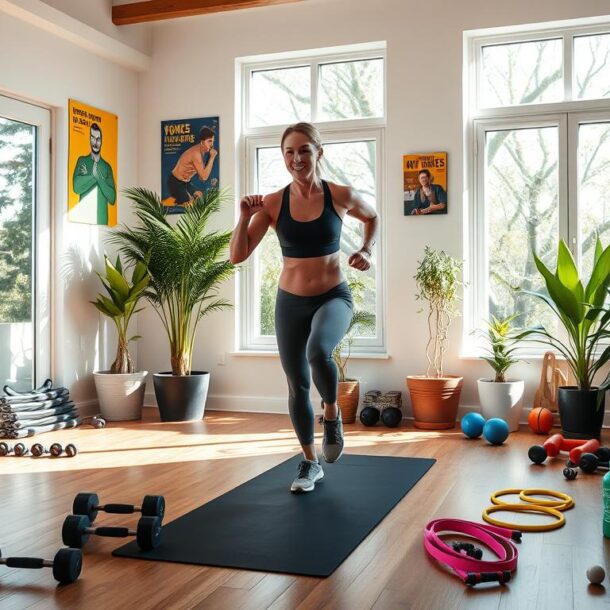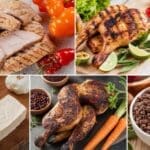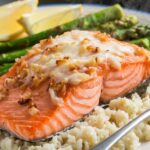
Please note: This website contains affiliate links. As an Amazon Associate, we earn from qualifying purchases at no additional cost to you.
This website contains affiliate links. As an Amazon Associate, we earn from qualifying purchases..
Did you know that salmon has a whopping 30.5 grams of protein in just half a fillet? This is just the start of the best high protein foods you can find. Whether you want to build muscle, lose weight, or just feel better, eating protein-rich meals is key.
Protein is essential for many body functions like cell structure, immune function, and making hormones. It’s made of amino acids, with nine being essential because our bodies can’t make them. Foods high in protein include eggs, nuts, lean meats, fish, dairy, and some grains.
For example, one large egg has 6.3 grams of protein1, making it a complete protein source. Almonds, a plant-based option, have 6 grams of protein per ounce1. They also give you important nutrients. A half chicken breast has 26.7 grams of protein1, and dairy products like cottage cheese have 28 grams of protein per cup1. These examples show how high protein foods can boost your diet.
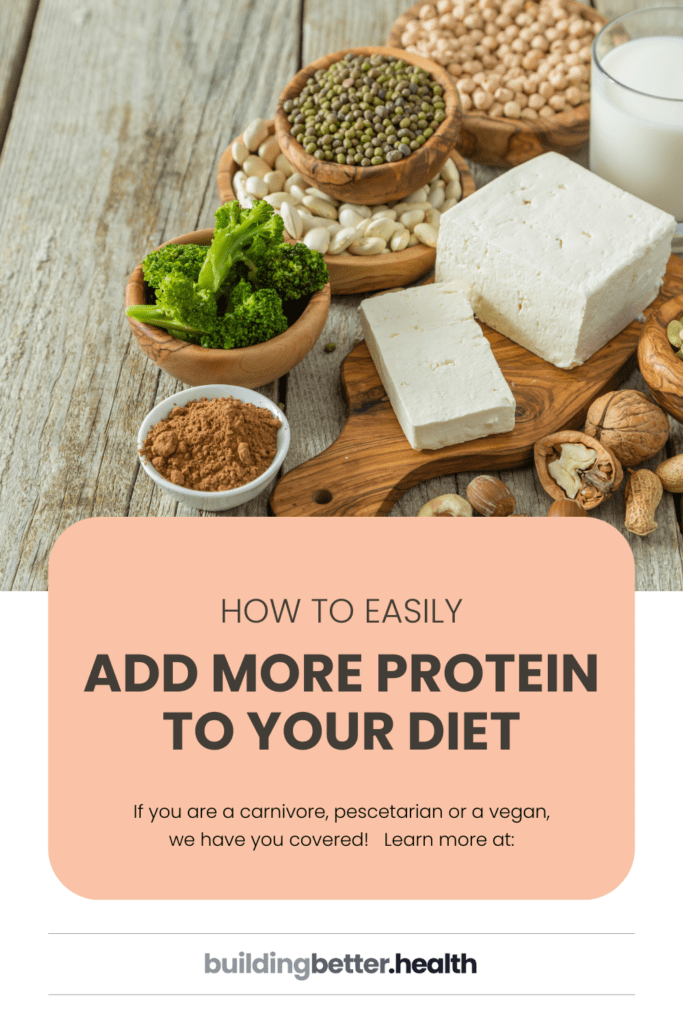
Introduction to High Protein Diets
Starting a high protein diet is a common way to get enough essential nutrients. Proteins are key for our body’s health, helping build muscles and carry out cell functions. And the more muscle you have the faster you’ll be able to burn calories, so this is KEY to maintaining a healthy weight.
Importance of Proteins
Proteins are vital for our body’s functions, like fixing tissues and making hormones. Eating more protein can make us feel full, which helps with weight control2. It also makes sure we get all the essential nutrients we need for health.
How much protein we need changes based on who we are. For example, pregnant women and athletes need more than others. Women should aim for a minimum 50 grams of protein a day, while men should aim for 60 grams. Many registered dieticians recommend a minimum of 100 grams of protein daily.
Basic Protein Needs
Knowing our basic protein needs is key. Adults should eat about 0.8 grams of protein for every kilogram of their weight3. So, a 150-pound person needs about 55 grams of protein each day.
The Dietary Guidelines say we should get 10 to 35% of our calories from protein. But people with certain health issues should talk to doctors before changing their diet.
It’s also good to eat a variety of protein sources at every meal. This includes animal proteins and plant-based options. Animal proteins have omega-3s, while plant-based foods are high in fiber and low in saturated fat3. Planning meals well helps us get enough protein and feel good about what we eat.
Animal-Based Protein Sources
Animal-based protein sources offer a wide range of options for a high-protein diet. You can find lean meats, seafood, and dairy products. These not only provide a lot of protein but also have health benefits.
Lean Meats
Lean meats are key for protein intake because they have less fat and more protein. For example:
- Grilled chicken breast has 32 grams of protein
- Grilled pork has 35.6 grams of protein
- Grass-fed lean ground beef has about 25 grams (4 oz serving)
Seafood
Seafood like salmon and cod is great for a high-protein diet. They are rich in protein and omega-3 fatty acids. Seafood is perfect for those who want to add heart-healthy fats to their diet.
If you want to incorporate more seafood into your diet, try canned salmon or Kirkland’s white albacore tuna – it offers about 45 grams of protein in ONE can (and only about 210 calories).
Dairy Products
Dairy products are good for protein and essential nutrients like calcium. Brazilian soft cheese has 24.2 grams of protein per 100 grams. Skim natural yogurt has 4 grams of protein per 100 grams.
2% milk has 3.23 grams of protein per 100 grams. It’s a valuable part of a balanced diet. We also love cottage cheese as a protein source, as it offers about 26 grams for a one cup serving.
Protein Content Comparison
| Food Item | Protein Content (per 100 grams) |
|---|---|
| Grilled Chicken Breast | 32 grams |
| Grilled Pork | 35 grams |
| Cooked Rabbit | 29 grams |
| Brazilian Soft Cheese | 24 grams |
| Skim Natural Yogurt | 4 grams |
| 2% Milk | 3.2 grams |
Comparing the protein in lean meats, seafood, and dairy helps make better choices. High-protein diets aim for 1 to 1.5 grams of protein per kilogram of body weight per day.
Plant-Based Protein Sources
Plant-based protein sources are great for those who follow a vegetarian or vegan diet. They also help those who want to mix up their protein intake. Legumes, nuts and seeds, and whole grains are key. They offer protein and important nutrients.
Legumes
Legumes like lentils, chickpeas, and beans are full of protein and nutrients. Lentils have 18 grams of protein per cup and are rich in fiber and iron7. Beans, such as kidney and black beans, have about 15 grams of protein per cup. They also have complex carbs and fiber7. Legumes are a top choice for plant-based protein.
Nuts and Seeds
Nuts and seeds are packed with protein, healthy fats, and fiber. Peanuts have 20.5 grams of protein per ½ cup, and almonds have 16.5 grams8. Hemp seeds have 9 grams of protein per 3-tablespoon serving. They also have magnesium and iron7. These foods are good for your health.
Whole Grains
Whole grains like quinoa and brown rice are good for protein and health. Quinoa has 8 grams of protein per cup and is full of fiber8. Spelt and teff grains have 10–11 grams of protein per cup. They are also rich in iron and B vitamins7. Adding whole grains to your meals helps keep your diet balanced.
| Food Source | Protein Per Serving | Additional Benefits |
|---|---|---|
| Lentils | 18 g per cooked cup | Fiber, antioxidants, iron |
| Kidney Beans | 15 g per cooked cup | Complex carbs, fiber, iron |
| Peanuts | 20.5 g per ½ cup | Healthy fats, fiber |
| Almonds | 16.5 g per ½ cup | Healthy fats, fiber |
| Quinoa | 8 g per cooked cup | Fiber, complete protein |
| Spelt and Teff | 10–11 g per cooked cup | Complex carbs, iron, B vitamins |
High Protein Foods for Vegetarians
Vegetarians have many high protein foods to choose from. These foods meet their protein needs and add variety to their diet. Let’s look at some great sources of protein for vegetarians.
Tofu and Tempeh
Tofu and tempeh come from soy and are key in vegetarian diets. They can be cooked in many ways and taste different. Tofu has 44 grams of protein per cup, and tempeh has 34 grams per cup910.
They are not just high in protein. They also have amino acids that help muscles repair and grow.
Quinoa
Quinoa is an ancient grain loved for its protein and nutrients. Cooked quinoa has 8 grams of protein and all nine essential amino acids10. It’s great in salads, bowls, and as a side to increase protein and keep diets balanced.
Dairy Alternatives
Dairy alternatives are vital for vegetarians, especially those avoiding dairy. Soy milk and almond milk are good protein sources. Soy milk has 7 grams of protein per cup, and almond milk has about 1 gram per cup10.
These alternatives are also packed with extra nutrients. They help vegetarians keep their protein levels up while enjoying their favorite drinks and dishes.
High Protein Snacks
High protein snacks are perfect for when you’re on the move or need a quick bite. They keep you energized and help you meet your protein needs.
Convenient Snack Options
There are many easy-to-grab snacks like Greek yogurt, nuts, and protein bars. Greek yogurt has 20 grams of protein in 200 grams11. Almonds give you 6 grams of protein per ounce, making them a healthy choice11. Beef jerky, with 9 grams of protein in 1 ounce, is also a favorite.
Mozzarella cheese has 12 grams of protein in three slices, and low-fat cottage cheese typically has 26 grams in one cup. Canned tuna packs 20 grams of protein in 3 ounces. Hard-boiled eggs, found in most stores, have about 12.5 grams of protein in two large eggs.
DIY High Protein Snacks
Homemade snacks are great too. You can mix peanut butter, whey protein powder, and oats to make tasty treats. Peanut butter has 9 grams of protein in 2 tablespoons11. It’s perfect for making energy balls and protein bars.
Adding chia seeds to Greek yogurt makes a snack that’s both healthy and tasty. Chia seeds have 4 grams of protein and 11 grams of fiber in two tablespoons. You can also make protein smoothies by blending Greek yogurt, fruit, and whey protein powder. This creates a refreshing drink that’s full of protein.
For those who love to cook, making protein-rich treats like oat-based cookies or homemade protein bars is a great idea. It’s a fun way to meet your daily protein needs.
| Protein Snack | Protein Content (grams) |
|---|---|
| Greek Yogurt (200 g) | 20 |
| Almonds (1 oz) | 6 |
| Low-fat Cottage Cheese (1/2 cup) | 12 |
| Beef Jerky (1 oz) | 9 |
| Hard-Boiled Eggs (2 large) | 12.5 |
| Peanut Butter (2 tbsp) | 9 |
| Chia Seeds (2 tbsp) | 4 |
High Protein Breakfast Ideas
Starting your day with a high protein breakfast helps you stay energized and full. You can mix egg dishes, protein smoothies, and high protein oatmeal. This mix gives you the nutrients you need for an active day.
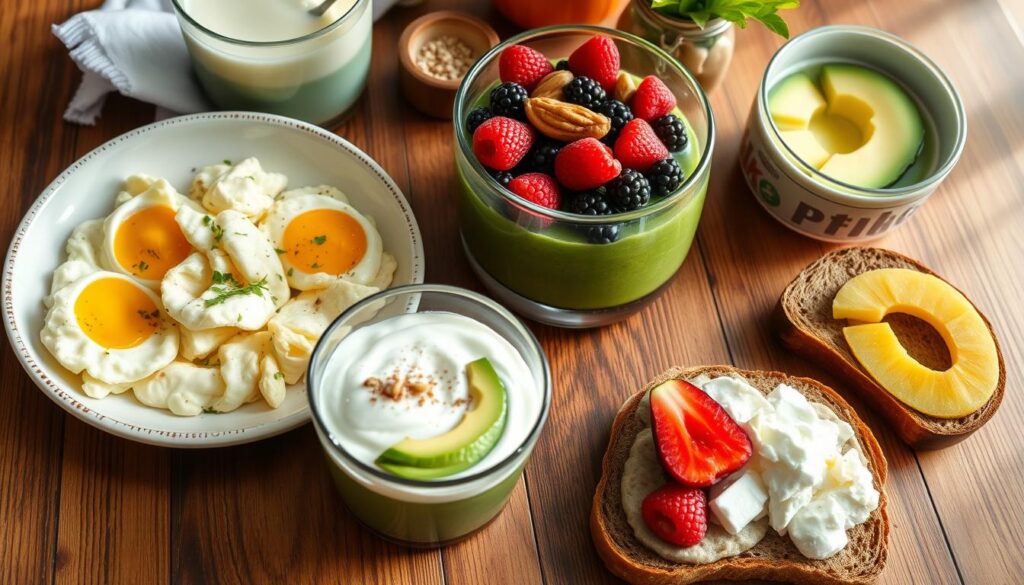
Egg Dishes
Egg dishes like omelets and scrambled eggs are great for a protein-packed start. One large egg has about 6 grams of protein. Adding cheese and veggies can increase this even more. A favorite dish is an omelet with cheese, garlic, tomatoes, peppers, and spinach. It has a 4.4 out of 5 star rating from 16 ratings13.
Protein Smoothies
Protein smoothies are perfect for those who love sweet tastes and need nutrients. They use whey or plant-based protein powders. Adding Greek yogurt, which has 10 grams of protein per 100 grams14, makes them even better. These smoothies are great for busy mornings because they’re tasty and easy to drink.
Here are just few of our favorite protein powders:
- Naked Pea Protein (unflavored) – you can even add this to your coffee each morning
- Orgain Organic Protein Powder (every flavor is delish!)
- Levels Grass-Fed Whey Protein Powder (multiple flavors available)
- Vega Protein & Greens – Plant-based with veggies!
- Naked Peanut Butter – perfect to mix with your chocolate protein powder!
TIP: You can also purchase pre-made protein shakes and many have between 20 to 42 grams of protein per serving. Fairlife, Core Power, Orgain, and Owyn are a few of our top picks.
High Protein Oatmeal
High protein oatmeal is a cozy breakfast choice. Adding nut butters like peanut butter (7 grams of protein per 2 tablespoons) or chia seeds (4.7 grams of protein per ounce) increases its protein. One of our favorite easy recipes is simply combining organic oats with Greek yogurt and blueberries.
Choosing these high-protein breakfasts helps you eat well and feel full for many hours. It’s the perfect way to start your day off on the right foot!
Best High Protein Meals for Lunch and Dinner
Lunch and dinner are great times to make high protein meals. You can choose from lean meats, seafood, or vegetarian options. There are many tasty recipes to try.
Chicken and Turkey Recipes
Chicken and turkey are top picks for high protein meals. They are lean and can be cooked in many ways like grilling, baking, or roasting. .
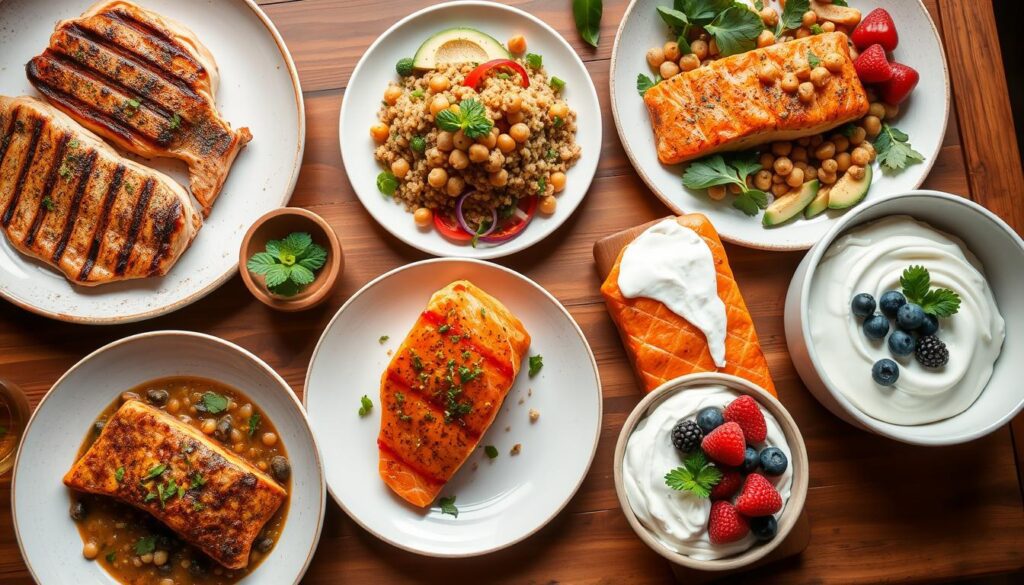
This website contains affiliate links. As an Amazon Associate, we earn from qualifying purchases at no additional cost to you.
Seafood-Based Meals
Seafood is another great choice for your high protein meals. Fish like salmon and tilapia are not only high in protein but also good for your heart.
If you are in a hurry and don’t have time for meal prep, try canned salmon or Kirkland’s white albacore tuna – it offers about 45 grams of protein in ONE can (and only about 210 calories).
Vegetarian High Protein Meals
Vegetarians have many high protein meal options without animal products. Tofu, beans, and lentils are great for making tasty, protein-rich meals. These meals can be made even more exciting with creative cooking methods.
Benefits of Incorporating High Protein Foods in Your Diet
Eating foods high in protein can help you in many ways. It can aid in weight loss and help build muscle. It also supports your overall health. By making sure 10% to 30% of your daily calories come from protein, you can feel full longer. This can help you eat fewer calories and lose weight17.
Weight Management
Protein is key for managing your weight. It makes you feel full and helps you eat fewer calories. For example, studies show that eating more protein can help overweight women eat 441 fewer calories a day without feeling hungry18.
High-protein diets also help burn more calories. They can burn an extra 80–100 calories each day18.
Muscle Building
If you’re active, protein is essential for fixing and growing muscles. Athletes need 1.2 to 2.2 grams of protein per kilogram of body weight daily. This helps build muscle and prevent muscle loss as you age.
More protein also helps you recover faster after injuries.
Overall Health Benefits
A high-protein diet has many health benefits. It helps make antibodies, balance blood sugar, and manage diabetes. It also boosts energy and keeps bones strong17.
High protein intake can also lower blood pressure. This is good for your heart18. Adding protein-rich foods like lean meats, fish, dairy, legumes, and nuts to your meals can make your diet healthier. It supports your health and well-being in the long run.

More Articles You Might Like:
How to Stop Eating So Much Sugar
Intermittent Fasting for Beginners
Turning Setbacks into Comebacks | Learning From “Off” Days
Please note: This website contains affiliate links. As an Amazon Associate, we earn from qualifying purchases at no additional cost to you.
Please note: This website contains affiliate links. As an Amazon Associate, we earn from qualifying purchases at no additional cost to you.


